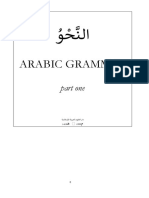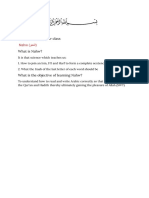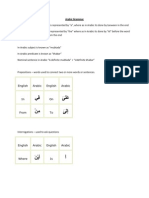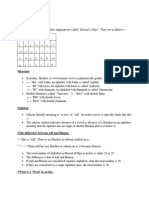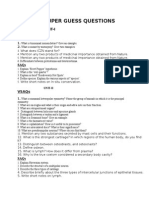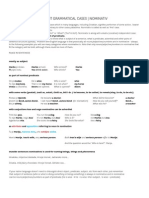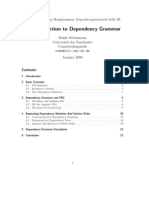Islamic Online University
Islamic Online University
Uploaded by
SK M BashaCopyright:
Available Formats
Islamic Online University
Islamic Online University
Uploaded by
SK M BashaOriginal Description:
Original Title
Copyright
Available Formats
Share this document
Did you find this document useful?
Is this content inappropriate?
Copyright:
Available Formats
Islamic Online University
Islamic Online University
Uploaded by
SK M BashaCopyright:
Available Formats
Islamic Online University
Introduction to Qurnic Arabic Level 1
Islamic
Online
University
Islamic Online University
Introduction to Qurnic Arabic Level 1
Introduction to
Qurnic Arabic
Level 1
By Masood Ahmed Ranginwala
Module 3a and 3b
http://www.islamiconlineuniversity.com
Islamic Online University
Introduction to Qurnic Arabic Level 1
Introduction to Arabic Grammar:The Arabic Word ][
I. The Four Characteristics of Arabic Nouns []
1. An Ism can be typically described as an Arabic noun. In this text, the term noun will be
synonymous with Ism.
2. It can be a person, place, object, adjective, verbal noun, or action (e.g. murder, anger).
3. Every Arabic Noun has four characteristics
i.
I'rb [
] - Case or inflection (grammatically known as nominative, accusative, or
genitive).
a) [ ] Raf (nominative)
b) [
]Nab (accusative)
c) [
] Jarr (genitive)
ii.
[ ] Number/plurality (single, dual, or plural)
iii.
[
]Gender (masculine or feminine)
iv.
[
]Definiteness (indefinite or definite)
Only nouns carry these four characteristics: Verbs and Particles have different rules and are
discussed later.
Knowing the four characteristics of a noun allows one to determine the "state" or inflection of the
word in a yah of the Qurn, or in a typical Arabic sentence. This is known as I'rb.
II. I'rb []
The I'rb of a noun points to the specific grammatical role that it has in a sentence. For example, in a verbal
sentence, the word that takes the Irb of Raf is identified as the Subject, while a word in the Nab case is
identified as the direct object of the verb. A word with the Irb of Jarr is either associated with a preposition or
functions in a role of possession. To determine the Irb of a noun, we need to examine the inflection on its last
letter. In order to do this, we first need to determine the other three qualities of the respective word, such as its
gender, plurality, and definiteness. We then examine the nouns ending vowel, and then subsequently determine
its Irb. Please note that verbs can also have Irb, but this in discussed later on the section on verbs. A better
understanding of Irb and inflection of Arabic words will be achieved by looking at the following examples and
principles presented in this Lesson.
http://www.islamiconlineuniversity.com
Islamic Online University
Introduction to Qurnic Arabic Level 1
1. The Three Types of Irb (for Nouns)
i.
Raf (Nominative)
Subject in a Verbal Sentence.
Subject and Predicate in a Nominal sentence.
In Arabic, there are up to eight conditions in which a noun can take the Raf case.
Some of these conditions are examined in this first Volume, while others are
discussed in Volume 2.
ii.
Nab (Accusative)
iii.
Object in a Verbal Sentence.
Objects of certain particles [
] .
Adverbs denoting detail in a sentence [] .
In Arabic, please note that there are up to twelve conditions where a noun can
take the Nab case. Some of these conditions are examined in this first Volume,
while others are discussed in Volume 2.
Jarr (Genitive)
Can denote possession, typically the word after of [].
Objects of preposition
[
]
In Arabic, there are only two conditions in which a noun can take Jarr, which have
been listed above.
2. Determining Irb of Nouns
Determining the Irb of nouns is done by examining the vowel ending on the last letter. The ammah
vowel typically denotes the case of Raf. The Fatah vowel denotes the Nab case whereas the Kasrah vowel
denotes the Jarr case. Please note that nouns that are indefinite typically carry Tanwn, whereas nouns that
are definite do not carry Tanwn. Even though identifying the last vowel usually allows one to successfully
determine the Irb, this is not often the case. There are several exceptions, particularly if the noun is not
singular. At this point we are only beginning to analyze the Arabic noun and the concept of Irb.
] at the end of a noun denotes Raf.
[ ] at the end on a noun typically denotes Nab.
1. ammah [
2. Fatah
http://www.islamiconlineuniversity.com
Islamic Online University
Introduction to Qurnic Arabic Level 1
(Exceptions are the partially flexible nouns like [ ] and [] .
] at the end of a noun denotes Jarr.
3. Kasrah [
Exceptions are rare such as words like [ ]and [ ]era h ib f btob Raf
here.
3. Identifying Singularity, Plurality and Duality of Nouns
Arabic nouns can come in the singular, dual, or plural tense. The specific number that is reflected
by any word depends on its morphology, and/or its ending. Unlike English, Arabic words are also
found in the dual form. Furthermore, they have multiple plural patterns.
i.
/
Dual Nouns and their Structure [
A dual noun can be readily identified by looking at its ending. It typically carries one of two
-]. Any noun in the single form can be converted to the dual form by simply
endings, [ ] or [
adding one of the two ends above to the end of the word. The specific dual ending is based on its
-] ending denotes Jarr or Nab.
Irb. The ending [ ] denotes Raf, while the [
a)
b)
-] Nab or Jarr
[
[ ] Raf
Irb of Singular and Dual Nouns
Singular (Raf)
word
beloved
Muslim
eye
Singular
1
(Nab)
Singular
(Jarr)
Dual (Raf)
Dual (Nab/Jarr)
For indefinite nouns which have a double Fatah ending (Fatah with Tanwn), an extra Alif is placed at the ending letter. The exception is the T
and not []. This Alif denotes a Fatah Tanwn if Tashkl is not present. It also
Marbtah. For example, for the word [
in Nab is []
indicates that the Alif be pronounced if a stop is made at that letter, as opposed to no pronunciation of the last vowel if it is a ammah or Kasrah
Tanwn.
http://www.islamiconlineuniversity.com
Islamic Online University
Introduction to Qurnic Arabic Level 1
Last adth of a al-Bukhri : Two words beloved words to Ar-Ramn, that are light
] .
on the tongue, heavy on the scales, [
]
]
In looking at this adth, the highlighted words are all dual, but we also see that some words with the
[ ] ending are not dual. For example, the following words
[ ,
, , ]are all single.
This shows that several words in Arabic exist with an [ ] ending that are not dual, but these are
exceptions.
Q
2
a al-Bukhri, Chapter on Tawhd:
, adth #7124.
http://www.islamiconlineuniversity.com
You might also like
- Rolemaster Express Double-Sided Character Sheet (English)Document2 pagesRolemaster Express Double-Sided Character Sheet (English)jwarlander100% (1)
- Arabic Language Lesson 1 9 Abu TaubahDocument28 pagesArabic Language Lesson 1 9 Abu Taubahadnan_aac100% (1)
- Literary Devices of DramaDocument2 pagesLiterary Devices of DramaReghEllorimo78% (9)
- The Arabicology BookDocument93 pagesThe Arabicology BookUsman Zouque100% (1)
- Fundamentals of Arabic Summary Nahwu Bayinnah TV, Access Online, Arabic With HusnaDocument24 pagesFundamentals of Arabic Summary Nahwu Bayinnah TV, Access Online, Arabic With HusnaS Sultan100% (17)
- Imlaa RulesDocument15 pagesImlaa RulesHalimaalitaliyyah100% (1)
- Present Tense Exercises. Polish A1Document6 pagesPresent Tense Exercises. Polish A1Pilar Moreno DíezNo ratings yet
- The Sixth Sense (1999)Document3 pagesThe Sixth Sense (1999)RubynewlandNo ratings yet
- Contemporary, Popular & Emergent LiteratureDocument2 pagesContemporary, Popular & Emergent LiteratureRod Tempra67% (3)
- Arnold I.v.lexicologyDocument293 pagesArnold I.v.lexicologyТанюшка Ткачук50% (2)
- Nahw The Grammatical States PlaygroundDocument7 pagesNahw The Grammatical States Playgroundapi-3709915No ratings yet
- ajrumiya EDITEDDocument82 pagesajrumiya EDITEDyrf87sq95dNo ratings yet
- Nahw The Grammatical States in Arabic LanguageDocument3 pagesNahw The Grammatical States in Arabic Languageapi-3709915No ratings yet
- Al AjrumiyyahDocument64 pagesAl AjrumiyyahSalman M100% (1)
- Arabic Language Lesson 1-9 - Abu TaubahDocument28 pagesArabic Language Lesson 1-9 - Abu TaubahAshraf Valappil100% (3)
- Arabic Grammar - WikipediaDocument28 pagesArabic Grammar - WikipediaAyesha TaslimNo ratings yet
- Parts of SpeechDocument11 pagesParts of Speechواحد عاليوتيوبNo ratings yet
- FSTU Nahw (2016)Document32 pagesFSTU Nahw (2016)Hammad AmjadNo ratings yet
- Arabic Grammar - WikipediaDocument28 pagesArabic Grammar - Wikipedia٠ຮꪋꮒꪱꮮ 鱻No ratings yet
- DuroosBook1 @piousfactsDocument5 pagesDuroosBook1 @piousfactsSpy ninjaNo ratings yet
- SarfDocument5 pagesSarfnisryneNo ratings yet
- ImalaDocument7 pagesImalamirkhwand100% (1)
- Arabic Reading Course Part 1 R2Document43 pagesArabic Reading Course Part 1 R2msajanjNo ratings yet
- ARABIC-GRAMMAR - Mawlana Tauha Karaan (May Allah Have Mercy Upon Him)Document45 pagesARABIC-GRAMMAR - Mawlana Tauha Karaan (May Allah Have Mercy Upon Him)abuhajira100% (1)
- NahwDocument44 pagesNahwnahid100% (1)
- The Translation of The Verbal Noun & The Verbal Adjective of - Ing Form in Chapter Thirty of The Translation of The Quran of M. M. Picktall & Mir A. AliDocument30 pagesThe Translation of The Verbal Noun & The Verbal Adjective of - Ing Form in Chapter Thirty of The Translation of The Quran of M. M. Picktall & Mir A. AliZINEB10No ratings yet
- Arabic Grammar Self StudyDocument13 pagesArabic Grammar Self Studyrhasnie100% (1)
- The linguistic definition of Sarf is a word صرف that is derived from the linguistic root ص ر ف meaning PDFDocument4 pagesThe linguistic definition of Sarf is a word صرف that is derived from the linguistic root ص ر ف meaning PDFmaryamNo ratings yet
- ArabicDocument15 pagesArabicShireen Ghazala100% (3)
- Madina Handout Book1Document40 pagesMadina Handout Book1apo1948No ratings yet
- Unlocking The AjrumiyyaDocument20 pagesUnlocking The AjrumiyyaSyafiq Borhannuddin100% (2)
- Unit One (1) : Learning The Language of Qur'anDocument6 pagesUnit One (1) : Learning The Language of Qur'anIsmail ThaniyullathilNo ratings yet
- Declinable or IndeclinableDocument3 pagesDeclinable or IndeclinableBadrul AhsanNo ratings yet
- Homework: Unit 7.1: Introduction To Arabic WordsDocument9 pagesHomework: Unit 7.1: Introduction To Arabic Wordsdrmuhsin100% (1)
- Lisan Al Arab Unit 1Document5 pagesLisan Al Arab Unit 1jabarikamau787No ratings yet
- Arabic Level 0 Class 1 161214135840Document24 pagesArabic Level 0 Class 1 161214135840Toufik MadaNo ratings yet
- My Arabic Language Lessons SeriesDocument14 pagesMy Arabic Language Lessons SeriesMădălina PapoiuNo ratings yet
- Differences Between Arabic and English Stress SystemDocument23 pagesDifferences Between Arabic and English Stress SystemPaweł Sawicki50% (2)
- Chapter of IraabDocument4 pagesChapter of IraabEnlightyour HeartNo ratings yet
- Persian Alphabet:: # Name Contextual FormsDocument24 pagesPersian Alphabet:: # Name Contextual FormsmeNo ratings yet
- Learn Arabic Grammar - Lesson 2Document5 pagesLearn Arabic Grammar - Lesson 2Islamic Treasure100% (1)
- Linguistic Miracle of QuranDocument125 pagesLinguistic Miracle of QuranShakkuNo ratings yet
- Ājrrūmiyyah's Introduction To: Edited and Translated by Imām WillDocument54 pagesĀjrrūmiyyah's Introduction To: Edited and Translated by Imām WillabuhajiraNo ratings yet
- Izāfat: I. How To Write ItDocument4 pagesIzāfat: I. How To Write Itdeevann100% (1)
- Linguisticmiracle 2nded PDFDocument125 pagesLinguisticmiracle 2nded PDFSabcMxyzNo ratings yet
- Lisanul Quran English - 1Document19 pagesLisanul Quran English - 1Roksana zzohaNo ratings yet
- Tajweed BookDocument14 pagesTajweed BookShahzaib AttariNo ratings yet
- DAIS Year 1 Term 1Document116 pagesDAIS Year 1 Term 1Sohaib AbdullahNo ratings yet
- Tajweed Rules For Quran RecitationDocument20 pagesTajweed Rules For Quran Recitationmilesbiles100% (1)
- Refuting Jhelumi's Claim That The Word Shaitan Is Repeated in Sacred Qur'an More Than All The Nouns /names of All Prophets With All Repetitions.Document12 pagesRefuting Jhelumi's Claim That The Word Shaitan Is Repeated in Sacred Qur'an More Than All The Nouns /names of All Prophets With All Repetitions.REPLYINGALIMIRZANo ratings yet
- Nahw (وﺣﻧﻟا) : LafdhDocument13 pagesNahw (وﺣﻧﻟا) : Lafdhnahid100% (1)
- TajweedDocument40 pagesTajweedshahidhaNo ratings yet
- حُرُوْفُ الجَرّ (The particles of jarr)Document5 pagesحُرُوْفُ الجَرّ (The particles of jarr)Radiah ZamanNo ratings yet
- NAHW Revision QuestionsDocument5 pagesNAHW Revision QuestionsSaarahNo ratings yet
- Word Stress and Vowel Neutralization in Modern Standard ArabicDocument6 pagesWord Stress and Vowel Neutralization in Modern Standard ArabicM0iris0MNo ratings yet
- Beginners Class-Wps OfficeDocument8 pagesBeginners Class-Wps Officesutemmy57No ratings yet
- Nahw - L2Document15 pagesNahw - L2drmuhsinNo ratings yet
- Arabic LetterDocument8 pagesArabic LetterAkariCameleónaMazdaNo ratings yet
- Sawitri 2012 The Science of MorphologyDocument17 pagesSawitri 2012 The Science of MorphologytbudionoNo ratings yet
- Non-Sound Verb in Ection in Arabic Allomorphic VariationDocument29 pagesNon-Sound Verb in Ection in Arabic Allomorphic Variationsolangia359No ratings yet
- Classical Arabic Sarf NahwDocument95 pagesClassical Arabic Sarf NahwAbu Abdelazeez100% (3)
- Nahw Meer: An English Guide To Arabic Sentences: Arabic Grammar, #2From EverandNahw Meer: An English Guide To Arabic Sentences: Arabic Grammar, #2No ratings yet
- Arabic Picture Dictionary: Learn 1,500 Arabic Words and Phrases (Includes Online Audio)From EverandArabic Picture Dictionary: Learn 1,500 Arabic Words and Phrases (Includes Online Audio)No ratings yet
- A Brief Summary of Qur'anic Grammar: Sarf and Nahw: Arabic Grammar, #1From EverandA Brief Summary of Qur'anic Grammar: Sarf and Nahw: Arabic Grammar, #1No ratings yet
- Zero Arabic Grammar 2, Lower Arabic Beginner Course: Arabic Linguistic Course, #2From EverandZero Arabic Grammar 2, Lower Arabic Beginner Course: Arabic Linguistic Course, #2No ratings yet
- Zoology Assignment For 10 - 01 - 2014 Test: Inhibin' Inhibits The Secretions ofDocument9 pagesZoology Assignment For 10 - 01 - 2014 Test: Inhibin' Inhibits The Secretions ofSK M BashaNo ratings yet
- Narayana Medical Academy, A.PDocument23 pagesNarayana Medical Academy, A.PSK M BashaNo ratings yet
- 1) All Except IV 2) All Except III 3) All Except II 4) AllDocument9 pages1) All Except IV 2) All Except III 3) All Except II 4) AllSK M BashaNo ratings yet
- Final LT - SPL Batch-Unit-24!08!2015 FinalDocument5 pagesFinal LT - SPL Batch-Unit-24!08!2015 FinalSK M BashaNo ratings yet
- Vigraham Final and LatestDocument64 pagesVigraham Final and LatestSK M Basha50% (2)
- Antigen Binding Site Is Present On Antibody BetweenDocument6 pagesAntigen Binding Site Is Present On Antibody BetweenSK M BashaNo ratings yet
- Botany-Morphology-Fill in The BlanksDocument10 pagesBotany-Morphology-Fill in The BlanksSK M Basha100% (2)
- ѨIâ◊√^Œú ɡ·Aöò „Qæo^Äœo "≥Å∞Qæ∞Ö'... : ... <Å<Å Q^Èœ=Úöˇ·# Å Kõ'« „Uñ¨Ê - - »‰Õω - Ç. - Ãçï„C 13:9Document48 pagesѨIâ◊√^Œú ɡ·Aöò „Qæo^Äœo "≥Å∞Qæ∞Ö'... : ... <Å<Å Q^Èœ=Úöˇ·# Å Kõ'« „Uñ¨Ê - - »‰Õω - Ç. - Ãçï„C 13:9SK M Basha100% (1)
- Paulu Drushtilo Devudu Evaru? Yesu Evaru? (Telugu)Document74 pagesPaulu Drushtilo Devudu Evaru? Yesu Evaru? (Telugu)SK M BashaNo ratings yet
- Do Muslims Believe in The TrinityDocument1 pageDo Muslims Believe in The TrinitySK M BashaNo ratings yet
- Super Guess QuestionsDocument6 pagesSuper Guess QuestionsSK M BashaNo ratings yet
- About Nominative Case - CroatianDocument2 pagesAbout Nominative Case - CroatianGrgoNo ratings yet
- Artemis Alexiadou ControlDocument14 pagesArtemis Alexiadou ControlAlexandra F100% (1)
- 032436606X 215918Document12 pages032436606X 215918majeeed100% (1)
- What Is Genre Blending?Document6 pagesWhat Is Genre Blending?Francis MaingiNo ratings yet
- Reduced Adverb Clauses Online DLADocument5 pagesReduced Adverb Clauses Online DLAAlberto MartínezNo ratings yet
- An Introduction To Dependency GrammarDocument16 pagesAn Introduction To Dependency Grammarrishabh295No ratings yet
- 10 Vital Grammar Rules and Best Writing PracticesDocument2 pages10 Vital Grammar Rules and Best Writing PracticessalmirzanNo ratings yet
- SMK Negeri 7 Mataram: Tugas Kelas OnlineDocument2 pagesSMK Negeri 7 Mataram: Tugas Kelas OnlineAsri DwiyantiNo ratings yet
- Stylistic Transformation (Eng)Document26 pagesStylistic Transformation (Eng)NayLin100% (1)
- FREE Music Lessons From Berklee College of Music: Songwriting: Essential Guide To RhymingDocument4 pagesFREE Music Lessons From Berklee College of Music: Songwriting: Essential Guide To RhymingRaphael PinheiroNo ratings yet
- Campfire Story RubricDocument2 pagesCampfire Story Rubricapi-236916699No ratings yet
- Sonnet 12 Analysis BetterDocument3 pagesSonnet 12 Analysis Betterapi-235445707No ratings yet
- HOLLYWOOD and MINING. PHD Natalia PetrovskayaDocument3 pagesHOLLYWOOD and MINING. PHD Natalia PetrovskayaIgor BobinNo ratings yet
- Lesson 8 - BasicDocument5 pagesLesson 8 - BasicMichael MccormickNo ratings yet
- Di (D') of DE A To A, HACIA Da From, By, Since DESDE in in EN Con With CON Tra, Fra Between ENTRE Su On SOBRE Per For PARADocument2 pagesDi (D') of DE A To A, HACIA Da From, By, Since DESDE in in EN Con With CON Tra, Fra Between ENTRE Su On SOBRE Per For PARAKarla SamsaNo ratings yet
- Instant Download Key Concepts in Contemporary Popular Fiction Key Concepts in Literature Bernice M. Murphy PDF All ChaptersDocument67 pagesInstant Download Key Concepts in Contemporary Popular Fiction Key Concepts in Literature Bernice M. Murphy PDF All Chaptersbangovigil53100% (2)
- Graphic NovelsDocument46 pagesGraphic Novelsapi-271284966No ratings yet
- LAN 105 Plotstructure 100119Document1 pageLAN 105 Plotstructure 100119jeffrey rugnaoNo ratings yet
- 4709 Kiem Tra Ngu Phap Tieng AnhDocument12 pages4709 Kiem Tra Ngu Phap Tieng AnhVõ Phi TrúcNo ratings yet
- Week 02 Tuesday Structure (Irvin García)Document4 pagesWeek 02 Tuesday Structure (Irvin García)karen gonzalezNo ratings yet
- Centro de Educación Básica Bilingüe "White Dove" Cuarto Grado B Teacher:Jonathan Arias Syllabus de Language Ii PeriodoDocument1 pageCentro de Educación Básica Bilingüe "White Dove" Cuarto Grado B Teacher:Jonathan Arias Syllabus de Language Ii PeriodoGisselle AlemanNo ratings yet
- New Latin Grammar PDFDocument276 pagesNew Latin Grammar PDFNarciso Karamazov100% (1)
- Exercise On Comparison of AdverbsDocument6 pagesExercise On Comparison of AdverbsJohnn B Albino100% (2)
- Verb Mood Lesson PlanDocument4 pagesVerb Mood Lesson Planapi-310262647100% (5)























